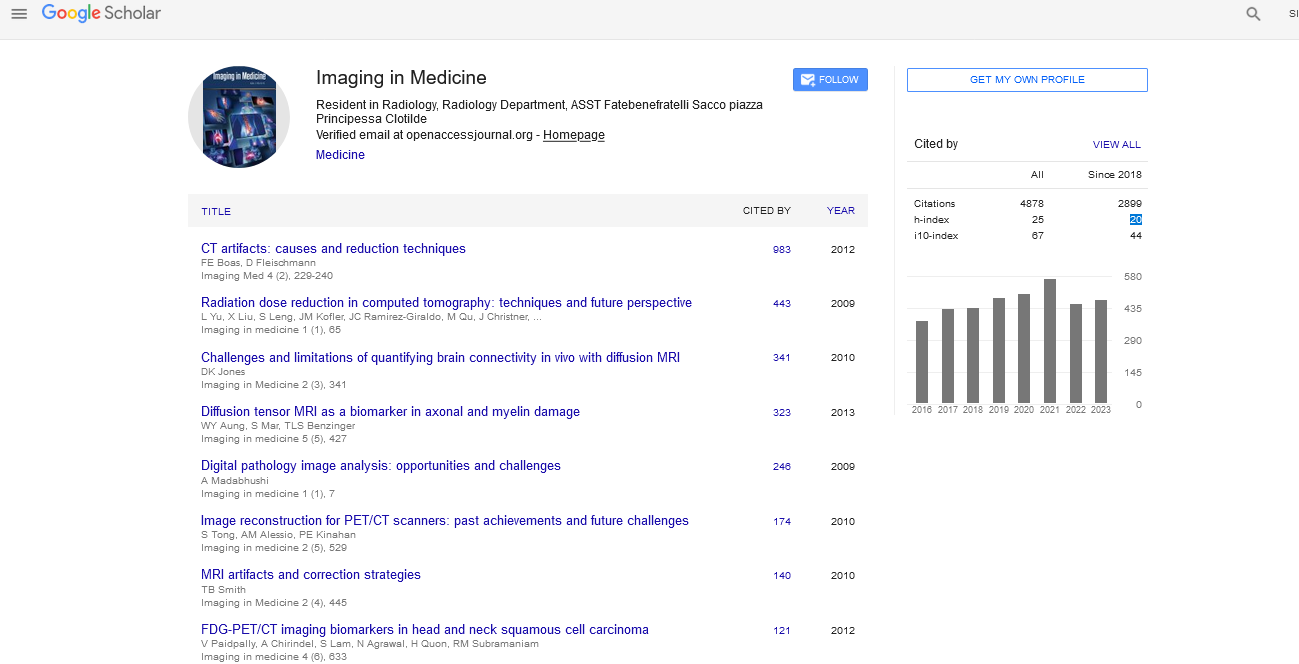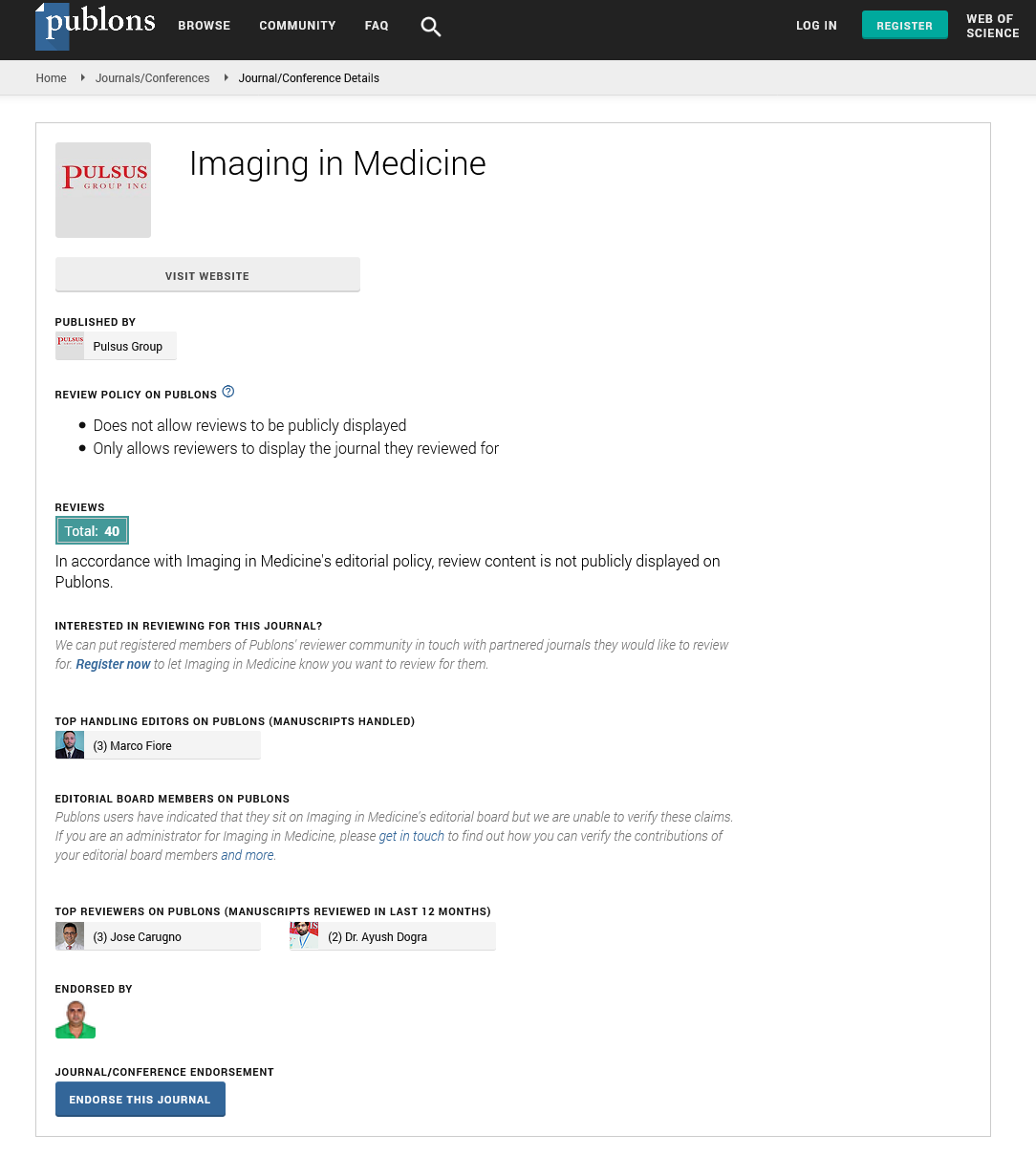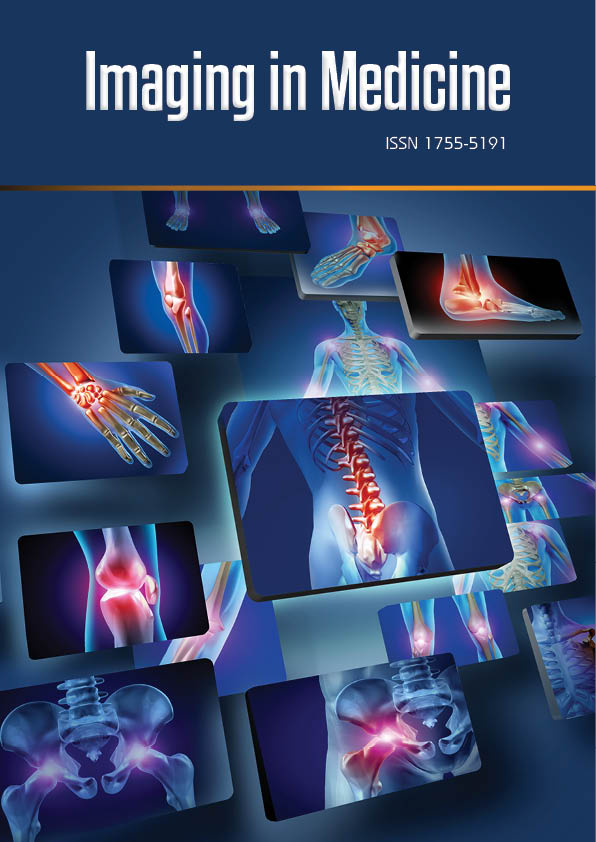Editorial - Imaging in Medicine (2025) Volume 17, Issue 1
Molecular Imaging: Visualizing Biology Beyond Structure
Ahmed Salem*
Department of Radiodiagnosis and Intervention, Alexandria University, Egypt
- *Corresponding Author:
- Ahmed Salem
Department of Radiodiagnosis and Intervention, Alexandria University, Egypt
E-mail: ahemad@gmail.com
Received: 17-Jan-2024, Manuscript No. fmim- 25-169968; Editor assigned: 20-Jan-2024, PreQC No. fmim-25-169968 (PQ); Reviewed: 04-October-2024, QC No. fmim-25-169968; Revised: 14-Jan-2024, Manuscript No. fmim- 25-169968 (R); Published: 21-Jan-2024, DOI: 10.47532/1755-5191.2025.17(1).1-3
Introduction
In modern medicine, the ability to look inside the human body has revolutionized diagnosis and treatment. Traditional imaging techniques such as X-rays, CT, and MRI primarily focus on anatomy and structure. However, many diseases begin with changes at the molecular or cellular level long before structural alterations appear [1]. Molecular imaging bridges this gap by allowing clinicians and researchers to visualize, characterize, and measure biological processes at the molecular and cellular scale in living organisms. This approach is transforming healthcare by enabling earlier detection of disease, better monitoring of treatment, and more personalized therapies.
What is Molecular Imaging?
Molecular imaging refers to a set of techniques that combine advanced imaging technologies with molecular probes or biomarkers to study specific biological pathways. Instead of merely showing organs and tissues, molecular imaging highlights physiological and biochemical processes, such as metabolism, receptor activity [2], and gene expression. By using specialized tracers that bind to molecules of interest, these methods can detect diseases like cancer, heart disease, and neurological disorders at their earliest stages.
Key Modalities in Molecular Imaging
Several imaging techniques are used in molecular imaging, often enhanced with targeted tracers:
Positron Emission Tomography (PET): Uses radiotracers (such as fluorodeoxyglucose, FDG) to measure metabolic activity, commonly applied in oncology and neurology.
Single-Photon Emission Computed Tomography (SPECT): Employs gamma-emitting tracers to study blood flow, organ function, and cellular activity [3].
Magnetic Resonance Imaging (MRI) with molecular contrast agents: Enhances visualization of specific tissues or receptors.
Optical Imaging: Uses fluorescence or bioluminescence to monitor cellular activity, often applied in research.
Hybrid Imaging (PET/CT, PET/MRI, SPECT/CT): Combines structural and molecular data, offering comprehensive insights into both anatomy and function.
Applications of Molecular Imaging
Molecular imaging is used across multiple medical specialties:
Oncology: PET scans are routinely used to detect tumors, stage cancers, monitor therapy, and evaluate recurrence. Tracers can also identify specific tumor markers, helping in personalized treatment.
Cardiology: Molecular imaging assesses blood flow, detects ischemia, and evaluates myocardial viability in patients with heart disease.
Neurology: PET and SPECT tracers help study brain metabolism, amyloid plaques in Alzheimer’s disease, dopamine activity in Parkinson’s disease, and seizure activity in epilepsy.
Infectious Diseases and Inflammation: Specialized tracers can highlight areas of infection or autoimmune activity.
Drug Development: Molecular imaging plays a major role in pharmaceutical research, enabling real-time evaluation of how new drugs interact with their biological targets [4].
Advantages of Molecular Imaging
The clinical value of molecular imaging comes from its unique ability to reveal function rather than just structure:
Early Detection: Identifies diseases at a molecular stage, before symptoms or anatomical changes appear.
Personalized Medicine: Helps tailor therapies based on the molecular characteristics of a patient’s disease.
Non-Invasive Monitoring: Tracks treatment effectiveness without repeated biopsies.
Comprehensive Insights: Provides both functional and structural information when combined with hybrid imaging technologies [5].
Accelerated Research: Speeds up drug discovery and development by showing real-time biological responses.
Limitations and Challenges
Despite its transformative potential, molecular imaging faces challenges:
Radiation Exposure: PET and SPECT involve radioactive tracers, though doses are generally low and safe.
Cost and Availability: The need for specialized scanners, tracers, and facilities makes it expensive and less accessible in some regions.
Short Half-Life of Tracers: Many radiotracers decay quickly, requiring proximity to production facilities.
Regulatory Hurdles: Approval processes for new tracers are lengthy and complex.
Technical Expertise: Requires highly trained personnel for imaging, analysis, and interpretation.
The Future of Molecular Imaging
The field of molecular imaging is advancing rapidly. Artificial intelligence is being integrated to enhance image interpretation, while novel tracers are being developed to target specific diseases, including rare cancers and neurodegenerative conditions. Portable imaging devices and hybrid platforms are expected to expand access. In the era of precision medicine, molecular imaging will likely become a key tool for tailoring treatment strategies to individual patients, optimizing outcomes, and minimizing unnecessary interventions.
Conclusion
Molecular imaging has shifted the focus of medical imaging from simply seeing anatomy to understanding biology at the molecular level. By detecting disease earlier, guiding personalized therapies, and accelerating research, it has become an indispensable tool in both clinical practice and biomedical science. While challenges such as cost, availability, and regulatory complexities remain, ongoing innovation promises to expand its applications and accessibility. As the technology continues to evolve, molecular imaging will play a central role in shaping the future of healthcare, providing deeper insights into disease and improving patient outcomes.
References
- Huang Z, Shen G, Gao J (2021) CDK1 promotes the stemness of lung cancer cells through interacting with Sox2. Clin Transl Oncol 23: 1743-1751.
- Yang J, Liu X, Cao S, Dong X, Rao S, et al. (2020) Understanding Esophageal Cancer: The Challenges and Opportunities for the Next Decade. Front Oncol 10: 1727.
- Sun X, Niwa T, Ozawa S, Endo J, Hashimoto J (2022) Detecting lymph node metastasis of esophageal cancer on dual-energy computed tomography. Acta Radiol 63: 3-10.
- Santamaria D, Barriere C, Cerqueira A, Hunt S, Tardy C, et al. (2007) Cdk1 is sufficient to drive the mammalian cell cycle. Nature 448: 811-815.
- Zhang P, Kawakami H, Liu W, Zeng X, Strebhardt K, et al. (2018) Targeting CDK1 and MEK/ERK Overcomes Apoptotic Resistance in BRAF-Mutant Human Colorectal Cancer. Mol Cancer Res 16: 378-389.
Google Scholar, Crossref, Indexed at
Google Scholar, Crossref, Indexed at
Google Scholar, Crossref, Indexed at
Google Scholar, Crossref, Indexed at


